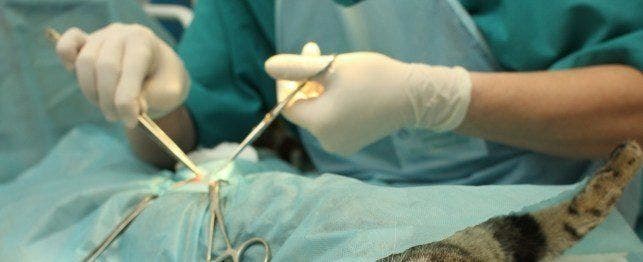
Gastrotomy in Cats
A gastrotomy is a surgical incision created in the wall of the stomach that allows the surgeon to examine the inside of the stomach. While abdominal x-rays, ultrasound examination and endoscopy are less invasive methods of examination, gastrotomy has an important role in diagnosis and treatment of gastrointestinal problems in cats.
What Are the Indications for Performing a Gastrotomy in Cats?
Gastrotomy is most often indicated for treatment of stomach problems including removal of foreign objects and stomach tumors in cats.
This procedure can also be done to obtain a biopsy sample of the stomach, repair abnormalities in the outflow of ingested material due to a narrowed sphincter, or repair a rupture, ulcer or severe trauma to the stomach.
What Preoperative Examinations or Tests Are Needed?
Preoperative tests depend in part on the age and general health of the animal as well as the cause for the gastrotomy. Radiographs (x-rays) or abdominal ultrasound typically is done to diagnose the underlying illness prior to surgery. Often a complete blood count, serum biochemical test, a urinalysis, and possibly an EKG will be performed prior to surgery.
What Type of Anesthesia Is Needed?
This is a surgical procedure that involves opening the abdominal cavity. General anesthesia is needed to induce unconsciousness, complete control of pain, and muscle relaxation. In the usual case, the cat will receive a pre-anesthetic sedative-analgesic drug to help him relax, a brief intravenous anesthetic to allow placement of a breathing tube in the windpipe, and subsequently inhalation (gas) anesthesia in oxygen during the actual surgery.
How Is a Gastrotomy Done in Cats?
Following anesthesia, the cat is placed on his back lying on the surgical table. The hair is clipped over the upper abdomen, the skin is scrubbed with surgical soap to disinfect the area and a sterile drape is placed over the surgical site. The incision is similar to a spay incision (midline). Your veterinarian uses a scalpel to incise the skin of the upper abdomen and to open the abdominal cavity. The stomach is isolated with sterile sponges and an incision is made. Any food or liquid is removed from the stomach to prevent abdominal contamination. The operation then continues; for example, the surgeon may remove a foreign object, a tumor, repair a rupture or take a biopsy sample. At the conclusion of the procedure, sutures (stitches) that dissolve over time are placed to close the incision in the stomach. The abdominal incision is then closed with one or two layers of self-dissolving sutures (stitches). The outer layer of skin is closed with sutures or surgical staples; these need to be removed in about 10 to 14 days.
How Long Does the Gastrotomy Take to Perform in Cats?
The procedure takes about 45 minutes to 1-1/4 hours to perform in most cases, including the needed time for preparation and anesthesia.
What Are the Risks and Complications?
The overall risk of this surgery is low. The major risks are those of general anesthesia, bleeding (hemorrhage), postoperative infection and wound breakdown (dehiscence) over the incision. Other complications maybe be dependent on underlying cause of the surgery as well as other concurrent diseases. Overall complication rate is low, but serious complications can result in death or the need for additional surgery.
What Is the Typical Postoperative Care in Cats?
Post-operative medication should be given to relieve pain, which is judged in most cases to be mild to moderate and can be eliminated with safe and effective pain medicines. Home care requires reduced activity until the stitches are removed in 10 to 14 days. You should inspect the suture line daily for signs of redness, discharge, swelling or pain and monitor your cat’s eating habits. For the first several days, a bland diet should be fed. The diet can then be slowly returned to normal. Signs of poor appetite, vomiting and obvious pain should prompt a call to your veterinarian.
How Long Is the Hospital Stay?
The typical stay following a gastrotomy is two to three days but will vary depending on the overall health of the cat and the underlying reason for the surgery.